
What species of bamboo plant exist across the globe?
If you regularly keep up with the latest health and wellness industry trends, you might have already come across the versatile uses of bamboo for your health and your environment. All this hype about bamboo plants and their many uses might have got you wondering what kind of species there are and how you can benefit from them. This article will help you discover the different bamboo species, their classification, distribution, and practical applications. Let's get right into it.
What is the Bamboo Plant Family All About?
As a member of the Poaceae grass family, bamboo is regarded as one of the fastest-growing plants in the world. There are 1700+ species of bamboo, and the plants are classified into around 116 genera, such as Bambusa, Dendrocalamus, and Phyllostachys. You can find these plants in different climates, from Southeast Asia's tropical regions to the temperate climates of North America.

What Different Types of Bamboo Exist?
The most common types of bamboo species that you need to know about are the Giant Bamboo, the Golden Bamboo, the Black Bamboo, and the Clumping Bamboo. The Giant Bamboo, also known as Moso bamboo or Phyllostachys edulis, is one of the largest and most commercially viable bamboo plants used worldwide. It originated in China and has been cultivated for centuries for its edible shoots and great use in construction and papermaking. This species can grow up to 30 metres tall and has thick stems with a 10cm radius.
On the other hand, the Golden Bamboo (Phyllostachys aurea) is seen mostly in gardens and landscaping thanks to its vibrant golden-yellow stems, which add an aesthetic touch to your environment. This species is also native to China and is instantly recognisable because of its yellow stems, green leaves, and occasional green stripes. The Golden Bamboo grows to around 10 metres and is often used to produce furniture and handicrafts.
The Black Bamboo (Phyllostachys nigra) is a striking bamboo plant with dark-coloured stems that almost become blackish as they mature and reproduce. They are also commonly used in landscaping because of their mysterious and attractive appearance. Occasionally, they are also used to manufacture furniture, construction materials, paper, and other craft items.
And finally, we have the Clumping Bamboo (Bambusa vulgaris), a bamboo species known for the way it grows in tight clusters. This is quite unusual for the bamboo family, as other species are known for their rapid and aggressive growth underneath and above the ground. The Clumping Bamboo is native to Southeast Asia and can grow up to 20 metres tall in the right conditions.
Where can Bamboo be Found Across the Globe?
While bamboo is well distributed globally, you'd be most likely to find it in Southeast Asia, particularly China, India, and Indonesia. There is also a fair concentration of different species in Africa, the Pacific Islands, and South and Central America. Depending on the climate, soil type, and general terrain of the area, it is possible to grow bamboo everywhere except in freezing temperatures. That being said, China remains the only country with the highest concentration of bamboo plants.
What Makes Each Bamboo Species Unique?
As we've detailed already, several factors make different bamboo species unique in their own ways. For example, Black Bamboo has quite dark stems, whereas Golden Bamboo is the complete opposite with its radiant colours. Similarly, Moso Bamboo is popular for its edible shoots, whereas Guadua Bamboo is better known for its strength. Other species are used more famously for their ornamental and decorative values.
How are Bamboo Species Used Practically Across the Globe
There are countless practical applications of bamboo worldwide, from construction and textiles to food and flooring. Since bamboo is a unique and sustainable material compared to timber and steel, and it is also strong, durable, and flexible, it has long since been a popular choice for manufacturing furniture and buildings. The fashion and textiles industries have also widely benefited from bamboo fabric, which is soft on the skin and gives it much more room to breathe. And lastly, bamboo seeds and shoots are also a significant part of cuisines worldwide, particularly in Asia.
Overall, it's remarkable how diverse the bamboo species is. Each species has unique traits and cultural significance that makes the entire family a vital plant which can help address many of our concerns regarding sustainability and environmentally friendly products.
![[UKDoubleVintagePinkCloudDuvetBundle] Hybrid Bamboo Pillows Couple Laying on a Mattress](http://pandalondon.com/cdn/shop/files/UK_Double_Vintage_Pink_Cloud_Bundle_Couple_laying.webp?v=1721303831&width=2000)

![[MattressTopper] Panda London Memory Foam Bamboo Mattress Topper package box](http://pandalondon.com/cdn/shop/files/Bamboo_Mattress_Topper_Package_Box.webp?v=1742301823&width=1500)
![[MattressTopper] Panda London Memory Foam Bamboo Mattress Topper on the floor](http://pandalondon.com/cdn/shop/products/Panda-Memory-Foam-Bamboo-Mattress-Topper-Yoga-e1624045454555.jpg?v=1758795458&width=1000)
![[MattressTopper] Bamboo Mattress Topper Lifestyle Image with Memory Foam Pillows Product Page](http://pandalondon.com/cdn/shop/files/Bamboo_Mattress_Topper_Lifestyle_Image_with_Memory_Foam_Pillows_Product_Page.webp?v=1758795458&width=800)
![[MattressTopper] Bamboo Mattress Topper Lifestyle Image with Bamboo Pillows In the Garden room Product Page](http://pandalondon.com/cdn/shop/files/Bamboo_Mattress_Topper_Lifestyle_Image_with_Bamboo_Pillows_In_the_Garden_room_Product_Page.webp?v=1758795458&width=800)
![[MattressTopper] Panda London Memory Foam Bamboo Mattress Topper side](http://pandalondon.com/cdn/shop/files/Mattress_Topper_Isolated_-_resized.jpg?v=1758795458&width=800)
![[HybridMattressPro] Main Image for Hybrid Bamboo Mattress Pro with all awards](http://pandalondon.com/cdn/shop/files/Hybrid_Bamboo_Mattress_Pro_Main_product_Image_with_awards.webp?v=1753971649&width=1000)
![[HybridMattressPro] Breathable Hybrid Bamboo Mattress](http://pandalondon.com/cdn/shop/products/Breathable-Hybrid-Bamboo-Mattress.jpg?v=1753971649&width=1920)
![[HybridMattressPro] Hybrid Bamboo Mattress Pro Cover Zip](http://pandalondon.com/cdn/shop/files/Hybrid_Bamboo_Mattress_Cover.jpg?v=1753971649&width=800)
![[HybridMattressPro] Panda Hybrid Bamboo Mattress Pro](http://pandalondon.com/cdn/shop/files/Hybrid_Bambo_Memory_Foam_Mattress_-_BioCell_Foam_x.jpg?v=1755095108&width=800)
![[HybridMattressPro] Couple on a Hybrid Bamboo Mattress Pro](http://pandalondon.com/cdn/shop/files/Hybrid_Bamboo_Mattress_Couple.jpg?v=1753971649&width=800)
![[CloudDuvet] Panda London The Cloud Bamboo Duvet Packaging](http://pandalondon.com/cdn/shop/products/Panda-London-The-Cloud-Bamboo-Duvet-Panda-Life-scaled_00a651ad-4ca3-4105-b520-12a94c1a4f71.jpg?v=1713363286&width=1920)
![[CloudDuvet] Panda London The Cloud Bamboo Duvet Rolled](http://pandalondon.com/cdn/shop/products/Duvet-Listing-Images03.jpg?v=1764079307&width=1000)
![[CloudDuvet] Panda London The Cloud Bamboo Duvet Girl Huggin a Duvet on the Bed](http://pandalondon.com/cdn/shop/files/Cloud_Bamboo_Duvet_-_Lady_Hugging_it_on_Bed_LifestyleImage.jpg?v=1764079307&width=1000)
![[CloudDuvet] Panda London The Cloud Bamboo Duvet Guy In the Air with Cloud Bamboo Duvet](http://pandalondon.com/cdn/shop/files/GuyonaHybridBambooMattresswithCloudDuvet.jpg?v=1764079307&width=2000)
![[CloudDuvet] Panda Cloud Duvet Winter on the bed lifestyle image](http://pandalondon.com/cdn/shop/files/Panda_Cloud_Duvet_Winter_on_the_Bed_Lifestyle-1_image.jpg?v=1764079307&width=1000)
![[BBWhite] White 100% Bamboo Bedding](http://pandalondon.com/cdn/shop/files/Pure_White_Full_Bed.webp?v=1719581797&width=1000)
![[BBWhite] White 100% Bamboo Bedding Texture](http://pandalondon.com/cdn/shop/files/100_Bamboo_Bedding_-_Pure_White_-_Close_Up_02.webp?v=1762879591&width=1000)
![[BBWhite] White 100% Bamboo Bedding Woman in bed sleeping](http://pandalondon.com/cdn/shop/files/100-Bamboo-Bedding-Set-Pure-White-BB.webp?v=1762879591&width=768)
![[BBWhite] White 100% Bamboo Bedding Woman Duvet cover buttons](http://pandalondon.com/cdn/shop/files/hand_and_buttons_1.webp?v=1762879591&width=1000)
![[BBWhite] White 100% Bamboo Bedding Woman in bed looking and smiling-](http://pandalondon.com/cdn/shop/files/SatonMadeBed-White100_BambooBedding-white_-_BB_SideShot1000x1000.webp?v=1762879591&width=980)
![[BBUrbanGrey] Urban Grey 100% Bamboo Bedding](http://pandalondon.com/cdn/shop/files/Made_Bed_-_Urban_Grey_-_Wide_Shot_2_1_1.webp?v=1762880019&width=1000)
![[BBUrbanGrey] Cloud Duvet Urban Grey 100% Bamboo Bedding Set](http://pandalondon.com/cdn/shop/files/Cloud_Duvet_-_Grey_-_Close_up_2.webp?v=1762880019&width=1000)
![[BBUrbanGrey] Urban Grey 100% Bamboo Bedding Set Woman sitting on the bed](http://pandalondon.com/cdn/shop/files/Sat_in_Bed_-_Grey_100__Bamboo_Bedding_-_Wide_Shot.webp?v=1762880019&width=1000)
![[BBUrbanGrey] Urban Grey 100% Bamboo Bedding Set Woman Duvet buttons Panda London](http://pandalondon.com/cdn/shop/files/hand_buttons_grey_bedding_1.webp?v=1762880019&width=1000)
![[BBUrbanGrey] Woman Sitting on the Bamboo Bedding with coffee](http://pandalondon.com/cdn/shop/files/SatonMadeBed-White100_BambooBedding-SideShot1000x1000.jpg?v=1762880019&width=1000)
![[BBNavyBlue] Deep Sea Navy Blue 100% Bamboo Bedding](http://pandalondon.com/cdn/shop/files/Made_Bed_-_Navy_-_Wide_Shot_3_copy.webp?v=1762879591&width=1000)
![[BBNavyBlue] Deep Sea Navy Blue 100% Bamboo Bedding Texture](http://pandalondon.com/cdn/shop/files/Cloud_Duvet_-_Navy_-_Close_up_2.webp?v=1762880019&width=1000)
![[BBNavyBlue] Deep Sea Navy Blue 100% Bamboo Bedding Woman Sitting on the bed](http://pandalondon.com/cdn/shop/files/Sat_Up_in_Bed_-_Navy_100__Bamboo_Bedding_-_Hands_on_Bed.webp?v=1762880019&width=1000)
![[BBNavyBlue] Deep Sea Navy Blue 100% Bamboo Bedding Duvet Cover Buttons](http://pandalondon.com/cdn/shop/files/Cloud_Duvet_Cover_Buttons_-_Deep_Sea_Navy.webp?v=1762880019&width=1000)
![[BBNavyBlue] Deep Sea Navy Blue 100% Bamboo Bedding Woman sitting on the bed looking away](http://pandalondon.com/cdn/shop/files/SatonMadeBed-White100_BambooBedding-SideShot1000x1000-001.webp?v=1762880019&width=980)
![[BBPink] Vintage Pink Blue 100% Bamboo Bedding](http://pandalondon.com/cdn/shop/files/Made_Bed_-_Pink_-_Wide_Shot_copy.webp?v=1762879591&width=1000)
![[BBPink] Vintage Pink Texture 100% Bamboo Bedding](http://pandalondon.com/cdn/shop/files/Cloud_Duvet_-_Pink_-_Close_up_2.webp?v=1762880019&width=1000)
![[BBPink] Vintage Pink Woman Sitting on the 100% Bamboo Bedding](http://pandalondon.com/cdn/shop/files/Sat_Up_in_Bed_-_Pink_-_Hands_on_Bed.webp?v=1762880019&width=1000)
![[BBPink] Vintage Pink Woman Sitting on the 100% Bamboo Bedding Duvet Cover](http://pandalondon.com/cdn/shop/files/Cloud_Duvet_Cover_Buttons_-_Vintage_Pink.webp?v=1762880019&width=1000)
![[BBPink] Vintage Pink Woman Sitting on the 100% Bamboo Bedding Woman looking far away](http://pandalondon.com/cdn/shop/files/SatonMadeBed-White100_BambooBedding-SideShot1000x1000-001_Vintage_Pink.webp?v=1762880019&width=980)
![[BBGrey] Light Grey 100% Bamboo Bedding](http://pandalondon.com/cdn/shop/files/Made_Bedding_in_Bedroom_-_Urban_Grey_-_Wide_Shot.webp?v=1762879591&width=1000)
![[BBGrey] Light Grey 100% Bamboo Bedding texture](http://pandalondon.com/cdn/shop/files/Texture17.webp?v=1762880019&width=1000)
![[BBGrey] Light Grey 100% Bamboo Bedding with Woman smiling](http://pandalondon.com/cdn/shop/files/Sat_Up_in_Bed_-_Grey_-_Hands_on_Bed.webp?v=1762880019&width=1000)
![[BBGrey] Light Grey 100% Bamboo Bedding with Duvet Cover buttons](http://pandalondon.com/cdn/shop/files/Cloud_Duvet_Cover_Buttons_-_Quiet_Grey.webp?v=1762880019&width=1000)
![[BBGrey] Light Grey 100% Bamboo Bedding with Woman smiling and sitting coffee](http://pandalondon.com/cdn/shop/files/SatonMadeBed-White100_BambooBedding-SideShot1000x1000-002-_Grey.webp?v=1762880019&width=980)
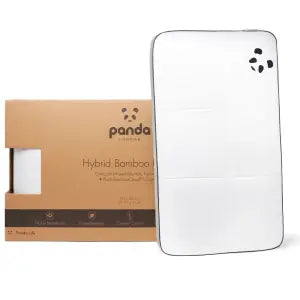 Hybrid Bamboo Pillow
Hybrid Bamboo Pillow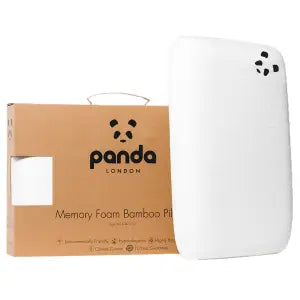 Memory Foam Bamboo Pillow
Memory Foam Bamboo Pillow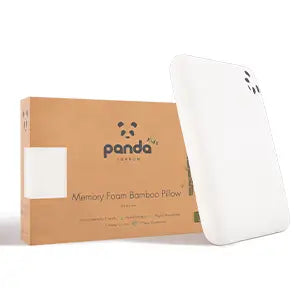 Kids Memory Foam Bamboo Pillow
Kids Memory Foam Bamboo Pillow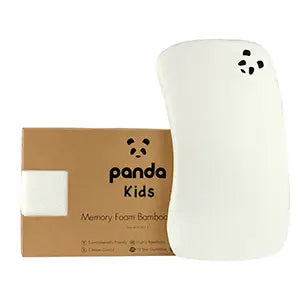 Baby Memory Foam Bamboo Pillow
Baby Memory Foam Bamboo Pillow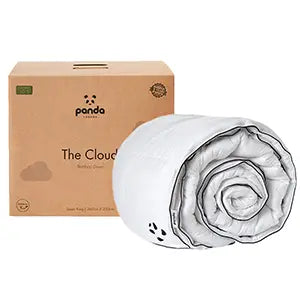 Panda Cloud Duvet
Panda Cloud Duvet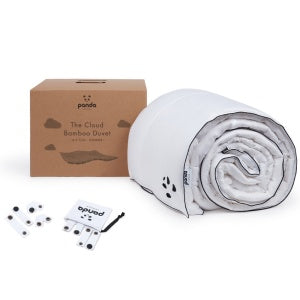 Bamboo Summer Duvet
Bamboo Summer Duvet Kids Cloud Duvet
Kids Cloud Duvet![[UKSingleNavyCloudDuvetBundle] Listing Packages Image](http://pandalondon.com/cdn/shop/files/UK_Single_Cloud_Bundle_Deep_Sea_Bedding_Listing_Image.webp?v=1721983932&width=4269)
![[UKSingleNavyCloudDuvetBundle] Guy Hugging Hybrid Bamboo Pillow and Smiling](http://pandalondon.com/cdn/shop/files/UKSingleDeepSeaNavyCloudBundleHuggingHybridBambooPillow.jpg?v=1721302039&width=768)
![[UKSingleNavyCloudDuvetBundle] Bamboo Eye Mask Panda London](http://pandalondon.com/cdn/shop/files/UKSingleDeepSeaNavyCloudBundleBambooEyeMask.webp?v=1721302039&width=1500)
![[UKSingleNavyCloudDuvetBundle] Bamboo Bedding Full Set](http://pandalondon.com/cdn/shop/files/UKSingleDeepSeaNavyCloudBundleBeddingSetFull.webp?v=1721302040&width=1000)
![[UKSingleNavyCloudDuvetBundle] Cloud Duvet from Panda London](http://pandalondon.com/cdn/shop/files/UKSingleDeepSeaNavyCloudBundlePandaBambooCloud.webp?v=1721302039&width=1637)
![[UKDoubleNavyCloudDuvetBundle] Listed all items Packaging](http://pandalondon.com/cdn/shop/files/UK_Double_DeepSeaNavy_Cloud_Bundle_-_Panda_London.webp?v=1721984628&width=4000)
![[UKDoubleNavyCloudDuvetBundle] Hybrid Bamboo Pillows Couples laying](http://pandalondon.com/cdn/shop/files/UK_Double_Deep_Sea_Navy_Cloud_Bundle_Couple_laying_on_a_Hybrid_Bamboo_Pillows.webp?v=1721302144&width=2000)
![[UKDoubleNavyCloudDuvetBundle] Bamboo Eye Mask from Panda London](http://pandalondon.com/cdn/shop/files/UK_Double_Deep_Sea_Navy_Cloud_Bundle_Bamboo_Eye_Mask.webp?v=1721302143&width=1500)
![[UKDoubleNavyCloudDuvetBundle] Full bamboo Bedding Set Deep Sea Navy](http://pandalondon.com/cdn/shop/files/UK_Double_Deep_Sea_Navy_Cloud_Bundle_Bedding_Set_Full.webp?v=1721302144&width=1000)
![[UKDoubleNavyCloudDuvetBundle] Panda London Cloud Duvet](http://pandalondon.com/cdn/shop/files/UK_Double_Deep_Sea_Navy_Cloud_Bundle_Panda_Bamboo_Cloud.webp?v=1721302143&width=1637)
![[UKSinglePureWhiteCloudDuvetBundle] Full listing packages](http://pandalondon.com/cdn/shop/files/UK_Single_Cloud_Bundle_White_Bedding_Listing_Image.webp?v=1721984022&width=4269)
![[UKSinglePureWhiteCloudDuvetBundle] Hybrid Bamboo Pillow Guy Holding and Smiling](http://pandalondon.com/cdn/shop/files/UK_Single_Pure_White_Cloud_Bundle_Hugging_Hybrid_Bamboo_Pillow.jpg?v=1721302450&width=768)
![[UKSinglePureWhiteCloudDuvetBundle] Guy Smiling while holding Bamboo Eye Mask](http://pandalondon.com/cdn/shop/files/UK_Single_Pure_White_Cloud_Bundle_Bamboo_Eye_Mask.webp?v=1721302450&width=1500)
![[UKSinglePureWhiteCloudDuvetBundle] Bamboo Bedding Full Set Pure White](http://pandalondon.com/cdn/shop/files/UK_Single_Pure_White_Cloud_Bundle_Bedding_Set_Full.webp?v=1721302451&width=1000)
![[UKSinglePureWhiteCloudDuvetBundle] Panda London Cloud Duvet](http://pandalondon.com/cdn/shop/files/UK_Single_Pure_White_Cloud_Bundle_Panda_Bamboo_Cloud.webp?v=1721302451&width=1637)
![[UKDoublePureWhiteCloudDuvetBundle] Listed all items Packaging](http://pandalondon.com/cdn/shop/files/UK_Double_PureWhite_Cloud_Bundle_-_Panda_London.webp?v=1721984700&width=4000)
![[UKDoublePureWhiteCloudDuvetBundle] Couple on a Hybrid Bamboo Pillows](http://pandalondon.com/cdn/shop/files/UK_Double_Pure_White_Cloud_Bundle_Pillows_Couple_laying_on_a_Hybrid_Bamboo_Pillows.webp?v=1721302574&width=2000)
![[UKDoublePureWhiteCloudDuvetBundle] bamboo eye Mask Urban Grey](http://pandalondon.com/cdn/shop/files/UK_Double_Pure_White_Cloud_Bundle_Bamboo_Eye_Mask.webp?v=1721302573&width=1500)
![[UKDoublePureWhiteCloudDuvetBundle] Full bamboo Bedding White Set](http://pandalondon.com/cdn/shop/files/UK_Double_Pure_White_Full_Bamboo_Bedding_Set.webp?v=1721302573&width=1000)
![[UKDoublePureWhiteCloudDuvetBundle] Panda London Cloud Duvet](http://pandalondon.com/cdn/shop/files/UK_Double_Pure_White_Cloud_Bundle_Panda_Bamboo_Cloud.webp?v=1721302573&width=1637)
![[UKSingleQuietGreyCloudDuvetBundle] Listing Packages Image](http://pandalondon.com/cdn/shop/files/UK_Single_Cloud_Bundle_Quiet_Grey_Listing_Image.webp?v=1721302882&width=2000)
![[UKSingleQuietGreyCloudDuvetBundle] Hybrid Bamboo Pillow with a guy](http://pandalondon.com/cdn/shop/files/UK_Single_Quiet_Grey_Cloud_Bundle_Hybrid_Bamboo_Pillow_Guy_Hugging.jpg?v=1721302882&width=768)
![[UKSingleQuietGreyCloudDuvetBundle] Bamboo Eye Mask Urban Grey](http://pandalondon.com/cdn/shop/files/UK_Single_Quiet_Grey_Cloud_Bundle_Eye_mask_Bamboo_Guy.webp?v=1721302882&width=1500)
![[UKSingleQuietGreyCloudDuvetBundle] Bamboo Bedding Quiet Grey](http://pandalondon.com/cdn/shop/files/UK_Single_Quiet_Grey_Cloud_Bundle_Full_Bamboo_Bedding_Set.webp?v=1721302883&width=1000)
![[UKSingleQuietGreyCloudDuvetBundle] Panda Cloud Duvet Panda London](http://pandalondon.com/cdn/shop/files/UK_Single_Quiet_Grey_Cloud_Bundle_Cloud_Duvet_Panda_London.webp?v=1721302882&width=1637)
![[UKDoubleQuietGreyCloudDuvetBundle] Listed Images Product Images](http://pandalondon.com/cdn/shop/files/UK_Double_LightGrey_Cloud_Bundle_-_Panda_London.webp?v=1721985378&width=4000)
![[UKDoubleQuietGreyCloudDuvetBundle] Couple laying on a Hybrid Bamboo Pillows](http://pandalondon.com/cdn/shop/files/UK_Double_Quiet_Grey_Cloud_Bundle_Pillows_Couple.webp?v=1721302995&width=2000)
![[UKDoubleQuietGreyCloudDuvetBundle] Urban Grey bamboo Eye mask](http://pandalondon.com/cdn/shop/files/UK_Double_Quiet_Grey_Cloud_Bundle_Bamboo_Eye_Mask.webp?v=1721302994&width=1500)
![[UKDoubleQuietGreyCloudDuvetBundle] Full Bamboo Bedding Quiet Grey](http://pandalondon.com/cdn/shop/files/UK_Double_Full_Bedding_Set_Quiet_Grey_Cloud_Bundle_Panda_London.webp?v=1721302995&width=1000)
![[UKDoubleQuietGreyCloudDuvetBundle] Panda London Cloud Duvet White](http://pandalondon.com/cdn/shop/files/UK_Double_Quiet_Grey_Cloud_Bundle_Panda_Bamboo_Cloud.webp?v=1721302994&width=1637)
![[UKSingleUrbanGreyCloudDuvetBundle] Hybrid Bamboo Pillow Duvet Mask Listing Products](http://pandalondon.com/cdn/shop/files/UK_Single_Cloud_Bundle_Urban_Grey_Bedding_Listing_Image.webp?v=1721984210&width=4269)
![[UKSingleUrbanGreyCloudDuvetBundle] Hybrid Bamboo Pillow Panda London](http://pandalondon.com/cdn/shop/files/UK_Single_Urban_Grey_Cloud_Duvet_Guy_Hugging_Pillow.jpg?v=1721303123&width=768)
![[UKSingleUrbanGreyCloudDuvetBundle] Bamboo Urban Grey Eye mask Panda London](http://pandalondon.com/cdn/shop/files/UK_Single_Urban_Grey_Cloud_Duvet_Bamboo_Eye_mask.webp?v=1721303123&width=1500)
![[UKSingleUrbanGreyCloudDuvetBundle] Full Bamboo Bedding Urban Grey Panda](http://pandalondon.com/cdn/shop/files/UK_Single_Urban_Grey_Cloud_Bundle_Bamboo_Full_Bedding_Set.webp?v=1721303124&width=1000)
![[UKSingleUrbanGreyCloudDuvetBundle] Cloud Duvet White Panda](http://pandalondon.com/cdn/shop/files/UK_Single_Urban_Grey_Cloud_Duvet_Panda_London.webp?v=1721303123&width=1637)
![[UKDoubleUrbanGreyCloudDuvetBundle] Listed Images Product Images](http://pandalondon.com/cdn/shop/files/UK_Double_UrbanGrey_Cloud_Bundle_-_Panda_London.webp?v=1721984772&width=4000)
![[UKDoubleUrbanGreyCloudDuvetBundle] Hybrid Bamboo Pillows and Couples sleeping](http://pandalondon.com/cdn/shop/files/UK_Double_Urban_Grey_Cloud_Bundle_Pillows_Couple.webp?v=1721303317&width=2000)
![[UKDoubleUrbanGreyCloudDuvetBundle] Urban Grey Mask Panda London](http://pandalondon.com/cdn/shop/files/UK_Double_Urban_Grey_Cloud_Bundle_Bamboo_Eye_Mask.webp?v=1721303480&width=1500)
![[UKDoubleUrbanGreyCloudDuvetBundle] Full Bamboo Bedding Urban Grey Set](http://pandalondon.com/cdn/shop/files/UK_Double_Urban_Grey_Cloud_Bundle_Bamboo_Full_Bedding_Set.webp?v=1721303481&width=1000)
![[UKDoubleUrbanGreyCloudDuvetBundle] Panda Cloud Duvet Panda London](http://pandalondon.com/cdn/shop/files/UK_Double_Urban_Grey_Cloud_Bundle_Panda_Bamboo_Cloud.webp?v=1721303480&width=1637)
![[UKSingleVintagePinkCloudDuvetBundle] Listed Images Product Images For Panda London](http://pandalondon.com/cdn/shop/files/UK_Single_Cloud_Bundle_Vintage_Pink_Bedding_Listing_Image.webp?v=1722599833&width=980)
![[UKSingleVintagePinkCloudDuvetBundle] Full Bamboo Bedding Vintage Pink Panda](http://pandalondon.com/cdn/shop/files/UK_Double_Vintage_Pink_Cloud_Bundle_Full_Bamboo_Bedding_Set_Panda_London.webp?v=1721303655&width=1000)
![[UKSingleVintagePinkCloudDuvetBundle] Hybrid Bamboo Pillow](http://pandalondon.com/cdn/shop/files/UK_Single_Urban_Grey_Cloud_Duvet_Guy_Hugging_Pillow_d3bc233c-ef79-4278-a417-24c04aa4e0c6.jpg?v=1721303654&width=768)
![[UKSingleVintagePinkCloudDuvetBundle] Bamboo Eye Mask Urban Grey](http://pandalondon.com/cdn/shop/files/UK_Single_Urban_Grey_Cloud_Duvet_Bamboo_Eye_mask_15007a00-9265-4902-aeae-e795a243031d.webp?v=1721303654&width=1500)
![[UKDoubleVintagePinkCloudDuvetBundle] Listed Images Product Images For Panda Londono](http://pandalondon.com/cdn/shop/files/UK_Double_Vintage_Pink_Cloud_Bundle_-_Panda_London.webp?v=1721984542&width=4000)
![[UKSingleVintagePinkCloudDuvetBundle] Panda London Cloud Duvet](http://pandalondon.com/cdn/shop/files/UK_Single_Urban_Grey_Cloud_Duvet_Panda_London_21b83930-e4ac-46be-b742-799dd64f53d1.webp?v=1721303654&width=1637)
![[UKDoubleVintagePinkCloudDuvetBundle] urban Grey bamboo Eye Mask](http://pandalondon.com/cdn/shop/files/UK_Double_Vintage_Pink_Cloud_Bundle_Bamboo_Eye_Mask.webp?v=1721303830&width=1500)
![[UKDoubleVintagePinkCloudDuvetBundle] Full Bamboo Bedding Set Vintage Pink](http://pandalondon.com/cdn/shop/files/UK_Double_Vintage_Pink_Cloud_Bundle_Full_Bamboo_Bedding_Set_Panda_London_d189f3c3-71ce-41d5-8d6b-b5ea0ab251a8.webp?v=1721303831&width=1000)
![[UKDoubleVintagePinkCloudDuvetBundle] Cloud Duvet Panda London](http://pandalondon.com/cdn/shop/files/UK_Double_Vintage_Pink_Cloud_Bundle_Panda_Bamboo_Cloud.webp?v=1721303830&width=1637)
![[Ink] Bamboo Bath Rug Ink - PandaLondon](http://pandalondon.com/cdn/shop/files/Bamboo-Rug-Ink-768x768-1_png.webp?v=1713359939&width=768)
![[Ink] Bamboo Bath Rug Ink Colour Lifestyle Image - PandaLondon](http://pandalondon.com/cdn/shop/files/Bamboo-Bath-Rug-Ink-Lifestyle-Image-768x768_jpg.webp?v=1713359784&width=768)
![[Ink] Bamboo Bath Rug Ink Colour Lifestyle Image on the floor - PandaLondon](http://pandalondon.com/cdn/shop/files/Bamboo-Bath-Rug-Ink-Lifestyle-768x768_jpg.webp?v=1713359783&width=768)
![[all] Bamboo Bath Rug All Colours Lifestyle Image - PandaLondon](http://pandalondon.com/cdn/shop/files/Bamboo-Bath-Rug-All-Colors-Image-768x1151_jpg.webp?crop=region&crop_height=768&crop_left=0&crop_top=191&crop_width=768&v=1713359780&width=768)
![[all] Bamboo Bath Rug All Colours - Panda London](http://pandalondon.com/cdn/shop/files/BambooBathRug-AllColors-ladder.jpg?crop=region&crop_height=768&crop_left=0&crop_top=191&crop_width=768&v=1714124221&width=768)
![[SandBathRug] Bamboo Bath Rug Sand - PandaLondon](http://pandalondon.com/cdn/shop/products/Bamboo-Rug-Sand-e1645030977819.png?v=1714124221&width=800)
![[SandBathRug] Bamboo Bath Rug Sand Lifestyle Image - PandaLondon](http://pandalondon.com/cdn/shop/files/Bamboo-Bath-Rug-Sand-Lifestyle-Image-768x768_jpg.webp?v=1714124221&width=768)
![[SandBathRug] Bamboo Bath Rug Sand Lifestyle Image on the floor - PandaLondon](http://pandalondon.com/cdn/shop/files/Bamboo-Bath-Rug-Sand-Lifestyle-768x768_jpg.webp?v=1714124221&width=768)
![[WhiteBathRug] Bamboo Bath Rug White - PandaLondon](http://pandalondon.com/cdn/shop/files/Bamboo-Rug-Pure-White-768x768-1_png.webp?v=1714124221&width=768)
![[WhiteBathRug] Bamboo Bath Rug White Lifestyle Image - PandaLondon](http://pandalondon.com/cdn/shop/files/Bamboo-Bath-Rug-Pure-White-Lifestyle-Image-768x768_jpg.webp?v=1714124221&width=768)
![[WhiteBathRug] Bamboo Bath Rug White Floor - PandaLondon](http://pandalondon.com/cdn/shop/files/Bamboo-Bath-Rug-Pure-White-Lifestyle-768x768_jpg.webp?v=1714124221&width=768)
![[UrbanGreyBathRug] Bamboo Bath Rug UrbanGrey - PandaLondon](http://pandalondon.com/cdn/shop/files/Bamboo-Bath-Rug-Urban-Grey-768x768-1_jpg.webp?v=1714124221&width=768)
![[UrbanGreyBathRug] Bamboo Bath Rug UrbanGrey Lifestyle Image - PandaLondon](http://pandalondon.com/cdn/shop/files/Bamboo-Bath-Rug-Urban-Grey-Lifestyle-Image-768x768_jpg.webp?v=1714124221&width=768)
![[UrbanGreyBathRug] Bamboo Bath Rug UrbanGrey on the floor - PandaLondon](http://pandalondon.com/cdn/shop/files/Bamboo-Bath-Rug-Urban-Grey-Lifestyle-768x768_jpg.webp?v=1714124221&width=768)
![[SingleDeepSeaNavyBundle] Products Images](http://pandalondon.com/cdn/shop/files/SingleUltimateBundleHybridMattress_HybridPillow_DeepSeaNavy.webp?v=1721234675&width=2000)
![[SingleDeepSeaNavyBundle] Guy Hugging Pillow](http://pandalondon.com/cdn/shop/files/ManhuggingHybridBambooPillow.jpg?v=1721237287&width=768)
![[SingleDeepSeaNavyBundle] The Panda Cloud Duvet](http://pandalondon.com/cdn/shop/files/The_Cloud_Ultimate_Mattress_Bundle_with_Eye_Mask_Single.webp?v=1721232711&width=1558)
![[SingleDeepSeaNavyBundle] Guy with Bamboo Panda Eye mask Grey](http://pandalondon.com/cdn/shop/files/EyeMask-CloseUp_Panda_London.webp?v=1721232690&width=1500)
![[SingleDeepSeaNavyBundle] Bamboo Mattress Protector For Ultimate Bundle Hybrid Mattress UK Single](http://pandalondon.com/cdn/shop/files/Hybrid_Bamboo_Mattress_Ultimate_Bundle_-_Bamboo_Mattress_Protector_UK_Doubles_Deep_Sea_Navy.webp?v=1721235916&width=980)
![[SingleDeepSeaNavyBundle] Full Bedding Set Deep Sea Navy](http://pandalondon.com/cdn/shop/files/SingleMattressFullBeddingSetDeepSeaNavy.jpg?v=1721237287&width=768)
![[DoubleDeepSeaNavyBundle] Hybrid Bamboo Bundle Products Images](http://pandalondon.com/cdn/shop/files/UK_Double_Deep_Sea_Navy_Ultimate_Hybrid_Bundle_-_Deep_Sea_Navy_1.webp?v=1721235650&width=2000)
![[DoubleDeepSeaNavyBundle] Couple](http://pandalondon.com/cdn/shop/files/UK_Double_Deep_Sea_Navy_Ultimate_Hybrid_Bundle_Double_Mattress_Couples_Deep_Sea_Navy11.jpg?v=1721235649&width=768)
![[DoubleDeepSeaNavyBundle] Cloud Panda Cloud](http://pandalondon.com/cdn/shop/files/UK_Double_Deep_Sea_Navy_Ultimate_Hybrid_Bundle_The_Cloud_Ultimate_Mattress_Bundle_with_Eye_Mask_Double1.webp?v=1721235650&width=1558)
![[DoubleDeepSeaNavyBundle] Eye mask Grey Coulour](http://pandalondon.com/cdn/shop/files/UK_Double_Deep_Sea_Navy_Ultimate_Hybrid_Bundle_EyeMask-CloseUp_Panda_London_Double_Deep_Sea_Navy_1.webp?v=1721235650&width=1500)
![[DoubleDeepSeaNavyBundle] Bamboo Mattress Protector For Ultimate Bundle Hybrid Mattress UK Single](http://pandalondon.com/cdn/shop/files/Hybrid_Bamboo_Mattress_Ultimate_Bundle_-_Bamboo_Mattress_Protector_UK_Single_Deep_Sea_Navy.webp?v=1721235916&width=980)
![[DoubleDeepSeaNavyBundle] Deep Sea Navy Bundle](http://pandalondon.com/cdn/shop/files/UK_Double_Deep_Sea_Navy_Ultimate_Hybrid_Bundle_Double_MattressFullBeddingSetDeepSeaNavy.webp?v=1721235649&width=768)
![[SingleUrbanGreyBundle] Products Images All for Bundles](http://pandalondon.com/cdn/shop/files/UK_Single_Ultimate_Bundle_-_Single_Urban_Grey_Packages_All_Zoomed.webp?v=1721237489&width=1966)
![[SingleUrbanGreyBundle] UK Bundle Single Guy Hugging the pillow](http://pandalondon.com/cdn/shop/files/UK_Single_Hugging_Hybrid_Bamboo_Pillow-Urban_Grey.jpg?v=1721237042&width=768)
![[SingleUrbanGreyBundle] Panda Cloud Duvet with eye mask](http://pandalondon.com/cdn/shop/files/UK_Single_Urban_Grey_Ultimate_Hybrid_Bundle_The_Cloud.webp?v=1721237043&width=1558)
![[SingleUrbanGreyBundle] Guy with Eye mask Urban Grey](http://pandalondon.com/cdn/shop/files/UK_Single_Urban_Grey_Ultimate_Hybrid_Bundle_EyeMask-CloseUp_Panda_London.webp?v=1721237042&width=1500)
![[SingleUrbanGreyBundle] Bamboo mattress protector](http://pandalondon.com/cdn/shop/files/Hybrid_Bamboo_Mattress_Ultimate_Bundle_-_Bamboo_Mattress_Protector_UK_Single_Urban_Grey.webp?v=1721237042&width=980)
![[SingleUrbanGreyBundle] Bamboo Bedding Panda London Urban Grey](http://pandalondon.com/cdn/shop/files/UK_Single_Urban_Grey_Ultimate_Hybrid_Bundle_Double_Mattress_Bamboo_Bedding_Full_Set_Urban_Grey.webp?v=1721237043&width=1000)
![[DoubleUrbanGreyBundle] Hybrid Bamboo Bundle Products Images All](http://pandalondon.com/cdn/shop/files/UK_Double_Ultimate_Bundle_-_Single_Urban_Grey_Packages_All.webp?v=1721237166&width=2000)
![[DoubleUrbanGreyBundle] Couples smiling](http://pandalondon.com/cdn/shop/files/UK_Double_Urban_Grey_Ultimate_Hybrid_Bundle_Double_Mattress_Couples.jpg?v=1721237166&width=768)
![[DoubleUrbanGreyBundle] Duvet White](http://pandalondon.com/cdn/shop/files/UK_Double_Urban_Grey_Ultimate_Hybrid_Bundle_The_Cloud.webp?v=1721237167&width=1558)
![[DoubleUrbanGreyBundle] Eye mask one eye](http://pandalondon.com/cdn/shop/files/UK_Double_Urban_Grey_Ultimate_Hybrid_Bundle_EyeMask-CloseUp_Panda_London.webp?v=1721237167&width=1500)
![[DoubleUrbanGreyBundle] Protector Mattress Panda](http://pandalondon.com/cdn/shop/files/Hybrid_Bamboo_Mattress_Ultimate_Bundle_-_Bamboo_Mattress_Protector_UK_Doubles_Urban_Grey.webp?v=1721237209&width=980)
![[DoubleUrbanGreyBundle] bamboo Bedding 100%](http://pandalondon.com/cdn/shop/files/UK_Double_Urban_Grey_Ultimate_Hybrid_Bundle_Double_Mattress_Bamboo_Bedding_Full_Set_Urban_Grey.webp?v=1721237167&width=1000)
![[SinglePureWhiteBundle] Products Images Pure White](http://pandalondon.com/cdn/shop/files/Ultimate_Bundle_-_UK_Single_Pure_White.webp?v=1721237931&width=2000)
![[SinglePureWhiteBundle] Guy with Hybrid Bamboo Pillow Panda London](http://pandalondon.com/cdn/shop/files/UK_Single_Hugging_Hybrid_Bamboo_Pillow-_Pure_White.jpg?v=1721237931&width=768)
![[SinglePureWhiteBundle] Panda Cloud Duvet London](http://pandalondon.com/cdn/shop/files/UK_Single_Pure_White_Ultimate_Hybrid_Bundle_The_Cloud.webp?v=1721237931&width=1558)
![[SinglePureWhiteBundle] Bamboo Eye Mask for Bundle](http://pandalondon.com/cdn/shop/files/UK_Single_Pure_White_Ultimate_Hybrid_Bundle_EyeMask-CloseUp_Panda_London.webp?v=1721237931&width=1500)
![[SinglePureWhiteBundle] Bamboo Mattress Protector Full](http://pandalondon.com/cdn/shop/files/Hybrid_Bamboo_Mattress_Ultimate_Bundle_-_Bamboo_Mattress_Protector_UK_Single_Pure_White.webp?v=1721237930&width=980)
![[SinglePureWhiteBundle] Full bamboo Bedding Set Panda London](http://pandalondon.com/cdn/shop/files/Single_Mattress_Full_Bedding_Set_Pure_White_Full.webp?v=1721237931&width=1000)
![[DoublePureWhiteBundle] Hybrid Bamboo Bundle Products Images All Pure White](http://pandalondon.com/cdn/shop/files/UK_King_size_Bundle_Pure_White.webp?v=1721238057&width=2000)
![[DoublePureWhiteBundle] Couple Looking into each other](http://pandalondon.com/cdn/shop/files/UK_Double_Pure_White_Ultimate_Hybrid_Bundle_Double_Mattress_Couples.jpg?v=1721238057&width=768)
![[DoublePureWhiteBundle] Panda Cloud Duvet London](http://pandalondon.com/cdn/shop/files/UK_Double_Pure_White_Ultimate_Hybrid_Bundle_The_Cloud.webp?v=1721238057&width=1558)
![[DoublePureWhiteBundle] Bamboo Eye Mask guy wearing and smiling](http://pandalondon.com/cdn/shop/files/UK_Double_Pure_White_Ultimate_Hybrid_Bundle_EyeMask-CloseUp_Panda_London.webp?v=1721238057&width=1500)
![[DoublePureWhiteBundle] Mattress Protector Bamboo](http://pandalondon.com/cdn/shop/files/Hybrid_Bamboo_Mattress_Ultimate_Bundle_-_Bamboo_Mattress_Protector_UK_Doubles_Pure_White.webp?v=1721238057&width=980)
![[DoublePureWhiteBundle] Bamboo White Bedding Full Set](http://pandalondon.com/cdn/shop/files/UK_Double_Mattress_Full_Bedding_Set_Pure_White_Panda_London.webp?v=1721238058&width=1000)
![[SingleQuietLightGreyBundle] All Grey Products Images Pure White](http://pandalondon.com/cdn/shop/files/Ultimate_Bundle_-_UK_Single_Quiet_Grey_Light_Grey.webp?v=1721239361&width=2000)
![[SingleQuietLightGreyBundle] Huggin Pillow Guy and Smiling](http://pandalondon.com/cdn/shop/files/UK_Single_Hugging_Hybrid_Bamboo_Pillow-_Light_Grey.jpg?v=1721239361&width=768)
![[SingleQuietLightGreyBundle] Panda Cloud Duvet London](http://pandalondon.com/cdn/shop/files/UK_Single_Grey_Light_Ultimate_Hybrid_Bundle_The_Cloud.webp?v=1721239361&width=1637)
![[SingleQuietLightGreyBundle] Eye Mask Bamboo Grey](http://pandalondon.com/cdn/shop/files/UK_Single_Light_Grey_Ultimate_Hybrid_Bundle_EyeMask-CloseUp_Panda_London.webp?v=1721239361&width=1500)
![[SingleQuietLightGreyBundle] Bamboo Mattress Protector Panda London](http://pandalondon.com/cdn/shop/files/Hybrid_Bamboo_Mattress_Ultimate_Bundle_-_Bamboo_Mattress_Protector_UK_Single_Light_Grey.webp?v=1721239360&width=980)
![[SingleQuietLightGreyBundle] Full Grey Bedding Set for Bundle](http://pandalondon.com/cdn/shop/files/Single_Mattress_Full_Bedding_Set_Light_Grey_Ultimate_Mattress_Bundle_Full.webp?v=1721239361&width=1000)
![[DoubleLightQuietGreyBundle] Hybrid Bamboo Bundle Products Images All Light Grey with Pink Eye Masks](http://pandalondon.com/cdn/shop/files/UK_Double_and_King_size_Ultiamte_mattress_Bundle_Quiet_Grey_Package.webp?v=1721239522&width=2000)
![[DoubleLightQuietGreyBundle] Couples smiling at each other on the Mattress](http://pandalondon.com/cdn/shop/files/UK_Double_Light_Grey_Ultimate_Hybrid_Bundle_Double_Mattress_Couples.jpg?v=1721239522&width=768)
![[DoubleLightQuietGreyBundle] Panda Cloud Duvet London](http://pandalondon.com/cdn/shop/files/UK_Single_Grey_Light_Ultimate_Hybrid_Bundle_The_Cloud_36a139df-c39f-4d97-a727-afcbaaa16416.webp?v=1721239522&width=1637)
![[DoubleLightQuietGreyBundle] Vintage Pink Eye mask girl smiling](http://pandalondon.com/cdn/shop/files/UK_Double_Ultimate_Mattress_Bundle_-_Bamboo_Eye_Mask_Vintage_Pink.webp?v=1721239522&width=2000)
![[DoubleLightQuietGreyBundle] Bamboo Mattress Protector Full in Panda London](http://pandalondon.com/cdn/shop/files/Hybrid_Bamboo_Mattress_Ultimate_Bundle_-_Bamboo_Mattress_Protector_UK_Doubles_Light_Grey.webp?v=1721239522&width=980)
![[DoubleLightQuietGreyBundle] Bamboo Bedding from panda London Light Grey](http://pandalondon.com/cdn/shop/files/UK_Double_Mattress_Full_Bedding_Set_Light_Grey_Bundle_Panda_London.webp?v=1721239523&width=1000)
![[SingleVintagePinkColorBundle] Vintage Pink Bundle with Vintage Pink Bedding Set and Eye Mask](http://pandalondon.com/cdn/shop/files/Ultimate_Bundle_-_Vintage_Pink_-_Single_Size_WEBP.webp?v=1738068146&width=2000)
![[SingleVintagePinkColorBundle] Hybrid Bamboo Pillow in Ultimate Bundle Vintage Pink Bundle with Vintage Pink Bedding Set and Eye Mask](http://pandalondon.com/cdn/shop/files/UK_Single_Hugging_Hybrid_Bamboo_Pillow-_Vintage_Pink-Set.jpg?v=1738068146&width=768)
![[SingleVintagePinkColorBundle] Cloud Duvet in Ultimate Bundle Vintage Pink Bundle with Vintage Pink Bedding Set and Eye Mask](http://pandalondon.com/cdn/shop/files/UK_Single_Vintage_Pink-_Ultimate_Hybrid_Bundle_The_Cloud-Set.webp?v=1738068146&width=1637)
![[SingleVintagePinkColorBundle] Ultimate Bundle Vintage Pink Bundle with Vintage Pink Bedding Set and Vintage Pink Eye Mask Girl holding Vintage Pink Eye Mask](http://pandalondon.com/cdn/shop/files/UK_Single_Ultimate_Mattress_Bundle_-_Bamboo_Eye_Mask_Vintage_Pink-Set.webp?v=1738068146&width=2000)
![[SingleVintagePinkColorBundle] Mattress Protector in Ultimate Bundle Vintage Pink Bundle with Vintage Pink Bedding Set and Eye Mask](http://pandalondon.com/cdn/shop/files/Hybrid_Bamboo_Mattress_Ultimate_Bundle_-_Bamboo_Mattress_Protector_UK_Single_Light_Grey_f163ce1f-8bdf-4572-a41f-d6f45aedb7fc.webp?v=1738068146&width=980)
![[SingleVintagePinkColorBundle] Ultiamte Bundle Vintage Pink Full Set Vintage Pink Bedding Set and Eye Mask](http://pandalondon.com/cdn/shop/files/Ultimate_Bundle_Single_Vintage_Pink_Bedding_Set_Color.webp?v=1738068146&width=1000)
![[DoubleVintagePinkColorBundle] Double Size Vintage Pink Bundle with Vintage Pink Bedding Set and Eye Mask](http://pandalondon.com/cdn/shop/files/Ultimate_Bundle_-_Vintage_Pink_-_Double_size_WEBP.webp?v=1738068146&width=2000)
![[DoubleVintagePinkColorBundle] Double Sizes Couples smiling at each other with a dog on the Mattress](http://pandalondon.com/cdn/shop/files/UK_Double_Coupleg_Hybrid_Bamboo_Pillow-_Vintage-Pink.webp?v=1738252516&width=1000)
![[DoubleVintagePinkColorBundle]Double Cloud Duvet in Ultimate Bundle Vintage Pink Bundle with Vintage Pink Bedding Set and Eye Mask](http://pandalondon.com/cdn/shop/files/UK_Double_Vintage-Pink_Ultimate_Hybrid_Bundle_The_Cloud.webp?v=1738068146&width=1637)
![[DoubleVintagePinkColorBundle] Double Ultimate Bundle Vintage Pink Bundle with Vintage Pink Bedding Set and Vintage Pink Eye Mask Girl holding Vintage Pink Eye Mask](http://pandalondon.com/cdn/shop/files/UK_Double_Ultimate_Mattress_Bundle_-_Bamboo_Eye_Mask_Vintage_Pink-Set.webp?v=1738068146&width=2000)
![[DoubleVintagePinkColorBundle] Double Mattress Protector in Ultimate Bundle Vintage Pink Bundle with Vintage Pink Bedding Set and Eye Mask](http://pandalondon.com/cdn/shop/files/Hybrid_Bamboo_Mattress_Ultimate_Bundle_-_Bamboo_Mattress_Protector_UK_Double_Vintage-Pink.webp?v=1738068146&width=980)
![[DoubleVintagePinkColorBundle] Ultiamte Bundle Vintage Pink Full Set Vintage Pink Bedding Set and Eye Mask](http://pandalondon.com/cdn/shop/files/Ultimate_Bundle_Double_Vintage_Pink_Bedding_Set_Color.webp?v=1738067960&width=1000)
![[BSUrbanGrey] Bath Sheet Bath Range Panda London Urban Grey](http://pandalondon.com/cdn/shop/files/01BathSheetBathRangePandaLondonUrbanGrey.webp?v=1750022805&width=1080)
![[BSUrbanGrey] Bath Sheet Bath Range Panda London Urban Grey Full Open Sheet](http://pandalondon.com/cdn/shop/files/02BathSheetBathRangePandaLondonFullSheetUrbanGrey.webp?v=1750022805&width=1080)
![[BSUrbanGrey] Bath Sheet Bath Range Panda London Urban Grey Full Stacked in Group](http://pandalondon.com/cdn/shop/files/03BathSheetBathRangePandaLondonStackedTowelsUrbanGreySideView.webp?v=1750022805&width=768)
![[BSUrbanGrey] Bath Sheet Bath Range Panda London Urban Grey Side View Grouped Towels](http://pandalondon.com/cdn/shop/files/04BathSheetBathRangePandaLondonStackedTowelsUrbanGrey.webp?v=1750022805&width=1000)
![[BSUrbanGrey] Bath Sheet Bath Range Panda London Urban Grey Side View Grouped Towels and Rolled](http://pandalondon.com/cdn/shop/files/05BathSheetBathRangePandaLondonStackedTowelsUrbanGreyRolled.webp?v=1750022805&width=1039)
![[BSUrbanGrey] Bath Sheet Bath Range Panda London Urban Grey Side View Grouped Towels on The Chair Lifestyle Image](http://pandalondon.com/cdn/shop/files/06BathSheetBathRangePandaLondonStackedTowelsUrbanGreyGrouped.webp?v=1750022805&width=1000)
![[BTUrbanGrey] Bath Towel Bath Range Panda London Urban Grey](http://pandalondon.com/cdn/shop/files/01_Bath_Towel_Bath_Range_Panda_London_Urban_Grey.webp?v=1750022805&width=1080)
![[BTUrbanGrey] Bath Towel Bath Range Panda London Urban Grey Full Opened](http://pandalondon.com/cdn/shop/files/02_Bath_Towel_Bath_Range_Panda_London_Urban_Grey_Full_Towel.webp?v=1750022805&width=1080)
![[BTUrbanGrey] Bath Towel Bath Range Panda London Urban Grey Stacked in Group](http://pandalondon.com/cdn/shop/files/03_Bath_Towel_Bath_Range_Panda_London_Stacked_Towels_Urban_Grey_Side_View.webp?v=1750022805&width=768)
![[BTUrbanGrey] Bath Towel Bath Range Panda London Urban Grey Stacked Side View Group](http://pandalondon.com/cdn/shop/files/04_Bath_Towel_Bath_Range_Panda_London_Stacked_Towels_Urban_Grey.webp?v=1750022805&width=1000)
![[BTUrbanGrey] Bath Towel Bath Range Panda London Urban Grey Rolled Stacked](http://pandalondon.com/cdn/shop/files/05_Bath_Towel_Bath_Range_Panda_London_Stacked_Towels_Urban_Grey_Rolled.webp?v=1750022805&width=1039)
![[BTUrbanGrey] Bath Towel Bath Range Panda London Urban Grey Stacked on the Chair Lifestyle image](http://pandalondon.com/cdn/shop/files/06_Bath_Towel_Bath_Range_Panda_London_Stacked_Towels_Urban_Grey_Grouped.webp?v=1750022805&width=1000)
![[HTUrbanGrey] Hand Towel Bath Range Panda London Urban Grey 1](http://pandalondon.com/cdn/shop/files/01_Hand_Towel_Bath_Range_Panda_London_Urban_Grey.webp?v=1750022805&width=1080)
![[HTUrbanGrey] Hand Towel Bath Range Panda London Urban Grey Full Opened 1](http://pandalondon.com/cdn/shop/files/02_Hand_Towel_Bath_Range_Panda_London_Urban_Grey_Full_Opened.webp?v=1750022805&width=1080)
![[HTUrbanGrey] Hand Towel Bath Range Panda London Urban Grey Stacked in Group all four 1](http://pandalondon.com/cdn/shop/files/03_Hand_Towel_Bath_Range_Panda_London_Stacked_Towels_Urban_Grey_Side_View.webp?v=1750022805&width=768)
![[HTUrbanGrey] Hand Towel Bath Range Panda London Urban Grey Stacked Grouped Side View 1](http://pandalondon.com/cdn/shop/files/04_Hand_Towel_Bath_Range_Panda_London_Stacked_Towels_Urban_Grey.webp?v=1750022805&width=1000)
![[HTUrbanGrey] Hand Towel Bath Range Panda London Urban Grey Rolled in Group 1](http://pandalondon.com/cdn/shop/files/05_Hand_Towel_Bath_Range_Panda_London_Stacked_Towels_Urban_Grey_Rolled.webp?v=1750022805&width=1039)
![[HTUrbanGrey] Hand Towel Bath Range Panda London Urban Grey On the Chair Lifestyle image 1](http://pandalondon.com/cdn/shop/files/06_Hand_Towel_Bath_Range_Panda_London_Stacked_Towels_Urban_Grey_Grouped.webp?v=1750022805&width=1000)
![[BSInkColour] Bath Sheet Bath Range Panda London Ink Colour](http://pandalondon.com/cdn/shop/files/01_Bath_Sheet_Bath_Range_Panda_London_Ink_Colour.webp?v=1750022805&width=1080)
![[BSInkColour] Bath Sheet Bath Range Panda London Ink Colour Full Sheet Opened](http://pandalondon.com/cdn/shop/files/02_Bath_Sheet_Bath_Range_Panda_London_Ink_Colour_Full_Sheet_Opened.webp?v=1750022805&width=1080)
![[BSInkColour] Bath Sheet Bath Range Panda London Ink Colour Stacked in Group](http://pandalondon.com/cdn/shop/files/03_Bath_Sheet_Bath_Range_Panda_London_Ink_Colour_Full_Towels_Grouped.webp?v=1750022805&width=1225)
![[BSInkColour] Bath Sheet Bath Range Panda London Ink Colour Side View](http://pandalondon.com/cdn/shop/files/04_Bath_Sheet_Bath_Range_Panda_London_Ink_Colour_Side_View_All_Towels.webp?v=1750022805&width=1000)
![[BSInkColour] Bath Sheet Bath Range Panda London Ink Colour Rolled in Group](http://pandalondon.com/cdn/shop/files/05_Bath_Sheet_Bath_Range_Panda_London_Ink_Colour_FoldedStacked.webp?v=1750022805&width=768)
![[BSInkColour] Bath Sheet Bath Range Panda London Ink Colour Stacked on the Chair Lifestyle Image](http://pandalondon.com/cdn/shop/files/06_Bath_Sheet_Bath_Range_Panda_London_Stacked_Towels_Ink_Colour_Grouped_on_the_Chair.webp?v=1750022805&width=768)
![[BTInkColour] Bath Towel Bath Range Panda London Ink Colour](http://pandalondon.com/cdn/shop/files/01_Bath_Towel_Bath_Range_Panda_London_Ink_Colour.webp?v=1750022805&width=1080)
![[BTInkColour] Bath Towel Bath Range Panda London Ink Colour Full Opene Bath Towel](http://pandalondon.com/cdn/shop/files/02_Bath_Towel_Bath_Range_Panda_London_Ink_Colour_Full_Towel.webp?v=1750022805&width=1080)
![[BTInkColour] Bath Towel Bath Range Panda London Ink Colour STacked in a Group](http://pandalondon.com/cdn/shop/files/03_Bath_Towel_Bath_Range_Panda_London_Ink_Colour_Full_Towels_Grouped.webp?v=1750022805&width=1225)
![[BTInkColour] Bath Towel Bath Range Panda London Ink Colour Side View](http://pandalondon.com/cdn/shop/files/04_Bath_Towel_Bath_Range_Panda_London_Ink_Colour_Side_View_All_Towels.webp?v=1750022805&width=1000)
![[BTInkColour] Bath Towel Bath Range Panda London Ink Colour Rolled Towels](http://pandalondon.com/cdn/shop/files/05_Bath_Towel_Bath_Range_Panda_London_Ink_Colour_FoldedStacked.webp?v=1750022805&width=768)
![[BTInkColour] Bath Towel Bath Range Panda London Ink Colour Stacked on the Chair](http://pandalondon.com/cdn/shop/files/06_Bath_Towel_Bath_Range_Panda_London_Stacked_Towels_Ink_Colour_Grouped_on_the_Chair.webp?v=1750022805&width=768)
![[HTInkColour] Hand Towel Bath Range Panda London Ink Colour](http://pandalondon.com/cdn/shop/files/01_Hand_Towel_Bath_Range_Panda_London_Ink_Colour.webp?v=1750022805&width=1080)
![[HTInkColour] Hand Towel Bath Range Panda London Ink Colour Full Opened](http://pandalondon.com/cdn/shop/files/02_Hand_Towel_Bath_Range_Panda_London_Ink_Colour_Full_Towel.webp?v=1750022805&width=1080)
![[HTInkColour] Hand Towel Bath Range Panda London Ink Colour Stacked grouped Face View](http://pandalondon.com/cdn/shop/files/03_Hand_Towel_Bath_Range_Panda_London_Ink_Colour_Full_Towels_Grouped.webp?v=1750022805&width=1225)
![[HTInkColour] Hand Towel Bath Range Panda London Ink Colour Stacked side View](http://pandalondon.com/cdn/shop/files/04_Hand_Towel_Bath_Range_Panda_London_Ink_Colour_Side_View_All_Towels.webp?v=1750022805&width=1000)
![[HTInkColour] Hand Towel Bath Range Panda London Ink Colour Rolled Towels](http://pandalondon.com/cdn/shop/files/05_Hand_Towel_Bath_Range_Panda_London_Ink_Colour_FoldedStacked.webp?v=1750022805&width=768)
![[HTInkColour] Hand Towel Bath Range Panda London Ink Colour Lifestyle Image](http://pandalondon.com/cdn/shop/files/06_Hand_Towel_Bath_Range_Panda_London_Stacked_Towels_Ink_Colour_Grouped_on_the_Chair.webp?v=1750022805&width=768)
![[BSWhite] Bath Sheet Bath Range Panda London Urban Grey](http://pandalondon.com/cdn/shop/files/01_Bath_Sheet_Bath_Range_Panda_London_Pure_White.webp?v=1750022805&width=1080)
![[BSWhite] Bath Sheet Bath Range Panda London Urban Grey Full Opened](http://pandalondon.com/cdn/shop/files/02_Bath_Sheet_Bath_Range_Panda_London_Full_Sheet_Pure_White.webp?v=1750022805&width=1080)
![[BSWhite] Bath Sheet Bath Range Panda London Urban Grey Full Stacked Grouped](http://pandalondon.com/cdn/shop/files/03_Bath_Sheet_Bath_Range_Panda_London_Stacked_Towels_Pure_White_Side_View.webp?v=1750022805&width=1225)
![[BSWhite] Bath Sheet Bath Range Panda London Urban Grey Side View](http://pandalondon.com/cdn/shop/files/04_Bath_Sheet_Bath_Range_Panda_London_Stacked_Towels_Pure_White.webp?v=1750022805&width=1225)
![[BSWhite] Bath Sheet Bath Range Panda London Urban Grey Rolled Stacked](http://pandalondon.com/cdn/shop/files/05_Bath_Sheet_Bath_Range_Panda_London_Stacked_Towels_Pure_White.webp?v=1750022805&width=1039)
![[BSWhite] Bath Sheet Bath Range Panda London Urban Grey Lifestyle Image](http://pandalondon.com/cdn/shop/files/06_Bath_Sheet_Bath_Range_Panda_London_Stacked_Towels_Pure_White_Grouped.webp?v=1750022805&width=1225)
![[BTWhite] Bath Towel Bath Range Panda London Pure White](http://pandalondon.com/cdn/shop/files/01_Bath_Towel_Bath_Range_Panda_London_Pure_White.webp?v=1750022805&width=1080)
![[BTWhite] Bath Towel Bath Range Panda London Pure White Full Open Sheet](http://pandalondon.com/cdn/shop/files/02_Bath_Towel_Bath_Range_Panda_London_Pure_White_Full_Open.webp?v=1750022805&width=1080)
![[BTWhite] Bath Towel Bath Range Panda London Pure White Stacked Gourped](http://pandalondon.com/cdn/shop/files/03_Bath_Towel_Bath_Range_Panda_London_Stacked_Towels_Pure_White_Side_View.webp?v=1750022805&width=1225)
![[BTWhite] Bath Towel Bath Range Panda London Pure White Side View](http://pandalondon.com/cdn/shop/files/04_Bath_Towel_Bath_Range_Panda_London_Stacked_Towels_Pure_White.webp?v=1750022805&width=1225)
![[BTWhite] Bath Towel Bath Range Panda London Pure White Rolled Stacked](http://pandalondon.com/cdn/shop/files/05_Bath_Towel_Bath_Range_Panda_London_Stacked_Towels_Pure_White.webp?v=1750022805&width=1039)
![[BTWhite] Bath Towel Bath Range Panda London Pure White Lifestyle Stacked on the Chair](http://pandalondon.com/cdn/shop/files/06_Bath_Towel_Bath_Range_Panda_London_Stacked_Towels_Pure_White_Grouped.webp?v=1750022805&width=1225)
![[HTWhite] Hand Towel Bath Range Panda London Pure White](http://pandalondon.com/cdn/shop/files/01_Hand_Towel_Bath_Range_Panda_London_Pure_White.webp?v=1750022805&width=1080)
![[HTWhite] Hand Towel Bath Range Panda London Pure White Full Sheet](http://pandalondon.com/cdn/shop/files/02_Hand_Towel_Bath_Range_Panda_London_Pure_White_Open_Towel.webp?v=1750022805&width=1080)
![[HTWhite] Hand Towel Bath Range Panda London Pure White Grouped in the stack](http://pandalondon.com/cdn/shop/files/03_Hand_Towel_Bath_Range_Panda_London_Stacked_Towels_Pure_White_Side_View.webp?v=1750022805&width=1225)
![[HTWhite] Hand Towel Bath Range Panda London Pure White Side View](http://pandalondon.com/cdn/shop/files/04_Hand_Towel_Bath_Range_Panda_London_Stacked_Towels_Pure_White.webp?v=1750022805&width=1225)
![[HTWhite] Hand Towel Bath Range Panda London Pure White Rolled Stacked](http://pandalondon.com/cdn/shop/files/05_Hand_Towel_Bath_Range_Panda_London_Stacked_Towels_Pure_White.webp?v=1750022805&width=1039)
![[HTWhite] Hand Towel Bath Range Panda London Pure White Stacked on the Chair lifestyle](http://pandalondon.com/cdn/shop/files/06_Hand_Towel_Bath_Range_Panda_London_Stacked_Towels_Pure_White_Grouped.webp?v=1750022805&width=1225)
